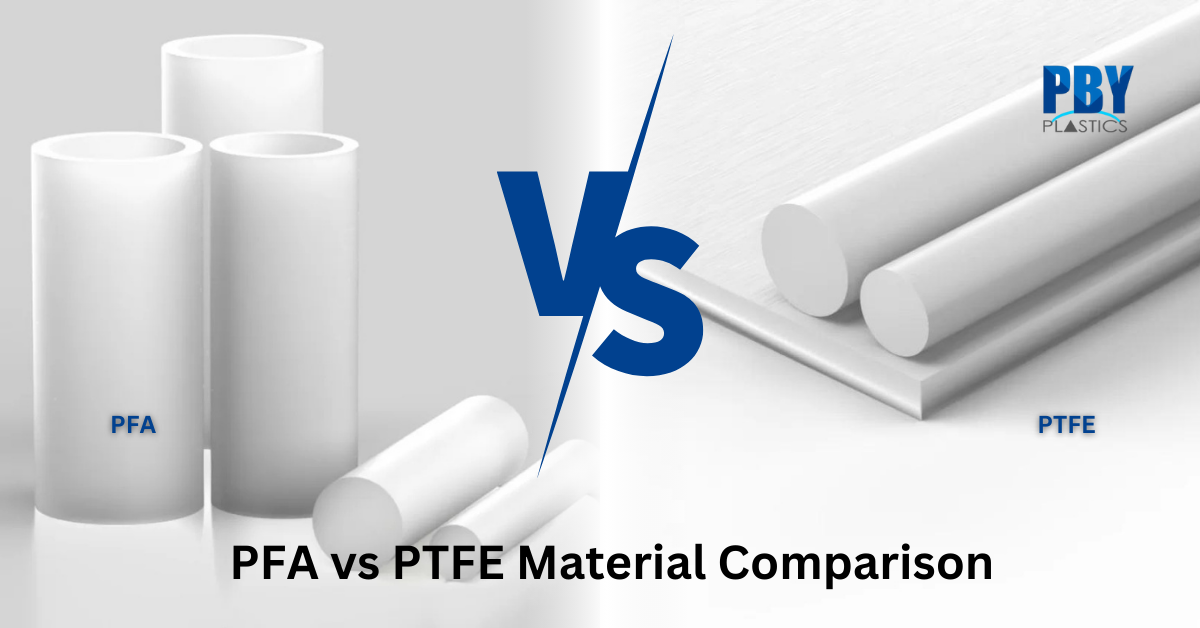PFA vs PTFE: Key Differences

When selecting materials for high-performance applications, understanding the differences between PFA and PTFE is crucial. Both materials are fluoropolymers and are known for their chemical resistance, nonstick properties, and high-temperature tolerance. However, they also have distinct characteristics that make them suitable for different applications.
Chemical Structure
PFA (perfluoroalkoxy) and PTFE (polytetrafluoroethylene) have similar chemical structures, both consisting of carbon and fluorine atoms. However, the difference lies in their molecular structure.
The Chemical Structure of PFA
PFA is a copolymer of tetrafluoroethylene with one or more perfluoroalkyl vinyl ether comonomers. Although it is similar to PTFE, it contains bulky side chains, the length of which depends on the type of alkyl group of the comonomer, i.e. -OCF3 in PMVE, -OCF2CF3 in PEVE, and -OCF2CF2CF3 in PPVE. The presence of these side chains allows PFA to be melt-processed. The melt point of PFA varies with the amount and type of perfluoroalkyl vinyl ether content of the copolymer. Additionally, its chemical structure gives PFA its high resistance to stress-cracking and its capability to maintain mechanical properties at elevated temperatures.
The Chemical Structure of PTFE
PTFE is another well-known fluoropolymer with a simple and robust chemical structure. It is composed entirely of carbon and fluorine atoms, forming a linear chain of repeating CF2 units. This structure gives PTFE its high chemical resistance and low surface energy.
One of the most notable features of PTFE's chemical structure is the strong carbon–fluorine bond. This bond is one of the strongest in organic chemistry, contributing to PTFE's stability and resistance to degradation. Unlike PFA, PTFE cannot be melt-processed, which limits its use in applications requiring complex shapes. However, PTFE excels in applications where low-friction properties are essential.
Properties
Comparing the properties of PFA and PTFE reveals several key differences that influence material selection.
Thermal Properties
Both PFA and PTFE exhibit excellent thermal stability, making them suitable for high-temperature applications. Both materials have a continuous service temperature of up to 260°C (500°F). While their maximum temperature ratings are the same, PFA's melt-processability provides an advantage in applications that require precise molding and fabrication.
Chemical Resistance
One of the primary reasons for choosing PFA or PTFE is their high chemical resistance. Both materials are resistant to a wide range of chemicals, including acids, bases, and solvents. However, PFA's chemical resistance and its weldability enhance its stability in aggressive environments. This makes PFA a preferred choice for applications involving harsh chemicals or prolonged exposure to corrosive substances, especially in the semiconductor industry.
Mechanical Properties
PFA and PTFE share several similarities in terms of mechanical properties. Both have high tensile strength, elongation at break, and low coefficient of friction. However, PFA has superior creep resistance at higher temperatures. PFA’s improved flexibility and ease of fabrication make it preferable for applications requiring greater adaptability, while PTFE is more effective in situations where its excellent low-friction and non-stick characteristics are essential, such as in seals, gaskets, and bearings.
Applications of PFA and PTFE
Applications of PFA
PFA is suitable for a wide range of applications across a variety of industries.
Chemical Processing
The chemical processing industry uses PFA for its superior chemical resistance and high-temperature stability. It is common in lining tanks, pipes, and fittings. PFA's melt-processability also allows for the production of complex shapes and intricate designs, making it ideal for custom applications.
Semiconductor Industry
The semiconductor industry uses PFA for its purity and resistance to contamination in the manufacturing of wafer carriers, tubing, and fittings as well as for lining reaction chambers and chemical delivery systems. PFA's capability to maintain its properties at elevated temperatures and in aggressive chemical environments makes it an essential material for semiconductor manufacturing.
Medical Devices
PFA's biocompatibility and chemical resistance make it suitable for use in medical devices and pharmaceutical applications. It is used for manufacturing tubing, catheters, and surgical instruments as well as for lining containers and equipment used in drug production. PFA's non-stick properties also reduce the risk of contamination and facilitate easy cleaning and sterilization.
Applications of PTFE
PTFE's unique properties make it suitable for a wide range of applications, particularly those requiring low friction and nonstick characteristics.
Applications of PTFE
In the aerospace industry, PTFE is used for manufacturing gaskets, seals, and bearings as well as for lining fuel tanks and hydraulic systems. Its low friction coefficient and high-temperature stability make it ideal for applications with extreme operating conditions. PTFE's chemical resistance ensures longevity and reliability in aerospace components.
Food Processing
The food processing industry uses PTFE for its non-stick properties and chemical resistance. It is used for manufacturing conveyor belts, baking sheets, and molds as well as for lining equipment and containers. PTFE's non-reactive nature and ease of cleaning make it suitable for applications involving direct contact with food products.
Electrical Insulation
PTFE's excellent dielectric properties make it an ideal material for electrical insulation applications. It is used for manufacturing wire and cable insulation as well as for lining connectors and other electrical components. PTFE's high-temperature stability and chemical resistance ensure reliable performance in demanding electrical environments.
Pros and Cons of PFA and PTFE
Pros and Cons of PFA
- Pros: high-temperature stability, higher purity, higher creep resistance at high temperatures, melt-processability, and weldability.
- Cons: Higher cost.
Pros and Cons of PTFE
- Pros: Strong carbon–fluorine bond and exceptional nonstick and low-friction properties
- Cons: non-melt-processable, and non-weldable.
Conclusion
Both PFA and PTFE have unique properties that make them valuable materials for various industrial applications. PFA's enhanced flexibility, processability, and superior chemical resistance make it suitable for applications requiring complex shapes and exposure to aggressive environments. PTFE's low friction, nonstick properties, and high-temperature stability make it ideal for applications where these characteristics are essential.
We are committed to helping you find the best solutions for your material needs, ensuring efficiency, reliability, and sustainability in your operations. Contact us for personalized advice to make the best choice for your project.